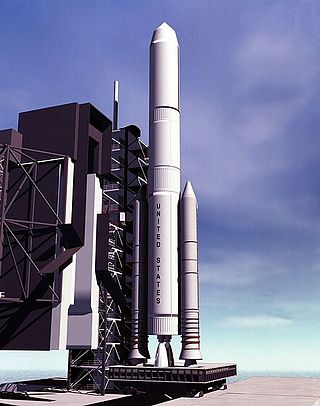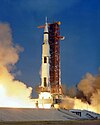
The S-IVB was the third stage on the Saturn V and second stage on the Saturn IB launch vehicles. Built by the Douglas Aircraft Company, it had one J-2 rocket engine. For lunar missions it was fired twice: first for Earth orbit insertion after second stage cutoff, and then for translunar injection (TLI).

AS-202 was the second uncrewed, suborbital test flight of a production Block I Apollo command and service module launched with the Saturn IB launch vehicle. It was launched on August 25, 1966, and was the first flight which included the spacecraft guidance, navigation control system and fuel cells. The success of this flight enabled the Apollo program to judge the Block I spacecraft and Saturn IB ready to carry men into orbit on the next mission, AS-204.

The Saturn family of American rockets was developed by a team of former German rocket engineers and scientists led by Wernher von Braun to launch heavy payloads to Earth orbit and beyond. The Saturn family used liquid hydrogen as fuel in the upper stages. Originally proposed as a military satellite launcher, they were adopted as the launch vehicles for the Apollo Moon program. Three versions were built and flown: the medium-lift Saturn I, the heavy-lift Saturn IB, and the super heavy-lift Saturn V.

The Saturn IB(also known as the uprated Saturn I) was an American launch vehicle commissioned by the National Aeronautics and Space Administration (NASA) for the Apollo program. It uprated the Saturn I by replacing the S-IV second stage, with the S-IVB. The S-IB first stage also increased the S-I baseline's thrust from 1,500,000 pounds-force (6,700,000 N) to 1,600,000 pounds-force (7,100,000 N) and propellant load by 3.1%. This increased the Saturn I's low Earth orbit payload capability from 20,000 pounds (9,100 kg) to 46,000 pounds (21,000 kg), enough for early flight tests of a half-fueled Apollo command and service module (CSM) or a fully fueled Apollo Lunar Module (LM), before the larger Saturn V needed for lunar flight was ready.
The Saturn I was a rocket designed as the United States' first medium lift launch vehicle for up to 20,000-pound (9,100 kg) low Earth orbit payloads. Its development was taken over from the Advanced Research Projects Agency (ARPA) in 1958 by the newly formed civilian NASA. Its design proved sound and flexible. It was successful in initiating the development of liquid hydrogen-fueled rocket propulsion, launching the Pegasus satellites, and flight verification of the Apollo command and service module launch phase aerodynamics. Ten Saturn I rockets were flown before it was replaced by the heavy lift derivative Saturn IB, which used a larger, higher total impulse second stage and an improved guidance and control system. It also led the way to development of the super-heavy lift Saturn V which carried the first men to landings on the Moon in the Apollo program.

A retrorocket is a rocket engine providing thrust opposing the motion of a vehicle, thereby causing it to decelerate. They have mostly been used in spacecraft, with more limited use in short-runway aircraft landing. New uses are emerging since 2010 for retro-thrust rockets in reusable launch systems.

The Magnum was a large super-heavy-lift rocket designed by NASA's Marshall Space Flight Center during the mid-1990s. The Magnum, which never made it past the preliminary design phase, would have been a launcher some 96 meters tall, on the scale of the Saturn V and was originally designed to carry a human expedition to Mars. It was to have used two strap-on side boosters, similar to the Space Shuttle Solid Rocket Boosters (SRBs), but using liquid fuel instead. Some designs had the strap-on boosters using wings and jet engines, which would enable them to fly back to the launch area after they were jettisoned in flight. The Magnum was designed to carry around 80 tons of payload into low Earth orbit (LEO).
Vaino Jack Vehko was an engineer for the Chrysler Corporation.

A modular rocket is a kind of multistage rocket which has components that can interchanged for different missions. Several such rockets use similar concepts such as unified modules to minimize expenses on manufacturing, transportation and for optimization of support infrastructure for flight preparations.

The Common Booster Core (CBC) was an American rocket stage, which was used on the Delta IV rocket as part of a modular rocket system. Delta IV rockets flying in the Medium and Medium+ configurations each used a single Common Booster Core as their first stage, while the Heavy configuration used three; one as the first stage and two as boosters. The Common Booster Core was 40.8 metres (134 ft) long, had a diameter of 5.1 metres (17 ft) and was powered by a single RS-68 engine burning liquid hydrogen and liquid oxygen.

The Saturn INT-20 was a proposed intermediate-payload follow-on from the Apollo Saturn V launch vehicle. A conical-form interstage would be fitted on top of the S-IC stage to support the S-IVB stage, so it could be considered either a retrofitted Saturn IB with a more powerful first stage, or a stubby, cut-down Saturn V without the S-II second stage.

The Saturn II was a series of American expendable launch vehicles, studied by North American Aviation under a NASA contract in 1966, derived from the Saturn V rocket used for the Apollo lunar program. The intent of the study was to eliminate production of the Saturn IB, and create a lower-cost heavy launch vehicle based on Saturn V hardware. North American studied three versions with the S-IC first stage removed: the INT-17, a two-stage vehicle with a low Earth orbit payload capability of 47,000 pounds (21,000 kg); the INT-18, which added Titan UA1204 or UA1207 strap-on solid rocket boosters, with payloads ranging from 47,000 pounds (21,000 kg) to 146,400 pounds (66,400 kg); and the INT-19, using solid boosters derived from the Minuteman missile first stage.
The Juno V series of rockets were a design that was proposed in the late 1950s but cancelled. The rockets were multi-stage and, although they failed to reach production, their sections were used in other designs.

The Saturn C-3 was the third rocket in the Saturn C series studied from 1959 to 1962. The design was for a three-stage launch vehicle that could launch 45,000 kilograms (99,000 lb) to low Earth orbit and send 18,000 kilograms (40,000 lb) to the Moon via trans-lunar injection.

The Saturn V-3, also known as the Saturn MLV 5-3, was a conceptual heavy-lift launch vehicle that would have utilized new engines and new stages that were never used on the original Saturn V. The Saturn V-3 was studied by the NASA Marshall Space Flight Center in 1965.
The Saturn V-C, was just like the Saturn V-B, studied in the same year as the V-C, except it would use a S-IVB second stage to get a payload into a higher orbit. A Centaur third stage was optional for deep space missions.
The Saturn V-D was a conceptual booster with the ability to launch three times as much payload as the Russian Energia booster. Studied in 1968, it was considered to be the mightiest of the proposed variations of the Saturn V rocket, rehashed as one of the boosters from the Boeing 1967 Saturn studies and utilizing the stage and a half Saturn V-B, four 100 ft tall SRBs, and the ordinary second and third stages of the original Saturn V. This booster never flew, but if it had been manufactured it would have had the capability to launch all the necessary components for a space station in one shot.
Studied by Douglas Aircraft Company in 1965, this rocket consisted of a whole Saturn IB with 4 strap-on SRBs that have flown on the Titan 3E interplanetary missile carriers. All components of the vehicle have flown, but not together for this concept.
RS-56 was an American liquid-fueled rocket engine, developed by Rocketdyne. RS-56 was derived from the RS-27 rocket engine, which itself is derived from the Rocketdyne H-1 rocket engine used in the Saturn I and Saturn IB. Two variants of this engine were built, both for use on the Atlas II rocket series. The first, RS-56-OBA, was a booster engine, while the RS-56-OSA was designed for use as a sustainer and produced lower thrust but at a higher specific impulse.

UA120 was a family of American solid rocket boosters, manufactured by the Chemical Systems Division of United Aircraft. Several variants existed, with a varying number of segments.













